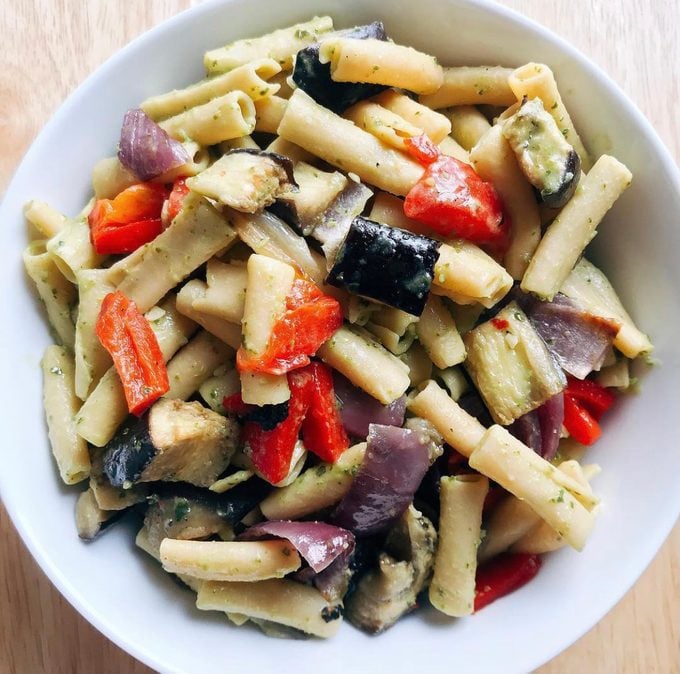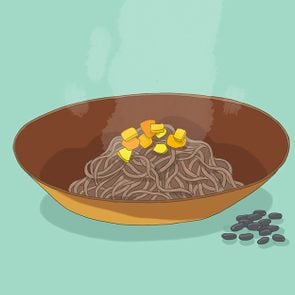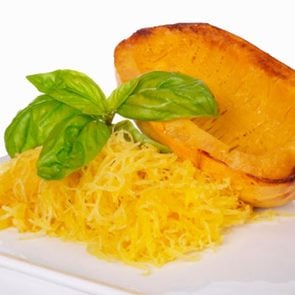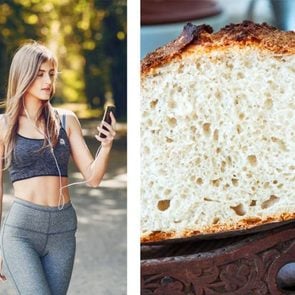The Healthy Pasta Recipe this Nutritionist Loves
Updated: Jan. 04, 2021
Yes, you can eat pasta and be healthy. Here's what a registered dietitian recommends for the perfect, balanced plate. Plus, her favorite go-to recipe.
It’s safe to say that in our low-carb obsessed, keto-crazed world, pasta has taken a beating. Well, I’m here to stand up for pasta. That’s right. I’m a dietitian, and I’m team pasta. I have the perfect healthy pasta recipe for you to try.
Pasta nutrition
But first, let’s cover the basic nutrition of pasta. One cup of cooked white pasta has about 200 calories, 7 grams of protein, 42 grams of carbs, 1 gram of fat, and 3 grams of fiber, according to the U.S. Department of Agriculture (USDA). Let’s talk about that for a second.
For a one-cup serving (which is about one-quarter the portion size served in many restaurants), you’re getting 42 grams of carbs, not a whole lot of protein, virtually no fat, and very little fiber. So, it’s safe to say that white pasta is made up predominantly of carbs. (Here’s why you can eat carbs and still be healthy.)
What happens when you eat pasta?
All carbohydrates contain sugar molecules, according to the journal Carbohydrate Research. When we eat carbs, we break down those sugar molecules into a compound that the body uses for energy—glucose. You with me so far?
When glucose enters the bloodstream, the pancreas is alerted and releases a hormone called insulin. Insulin is essentially the boss of blood sugar. It’s what signals the body’s cells to allow glucose in, to use it as energy. Every single cell in the body uses glucose—from brain cells that help us think, to muscle cells that help us move.
The rate of glucose entering the bloodstream—and causing blood sugar to rise—can be either fast or slow. And it’s affected by a few different things. When we eat foods that are comprised mainly of carbs, we digest those carbs rather quickly, and the blood sugar spikes rather quickly. However, when we eat carbs with other nutrients—such as protein, fat, and fiber—that digestion process is much slower, as research, including a study published in a 2018 issue of Starch, has shown.
Think about it: Now the body’s work is a bit more complex. Not only does it have to digest the carbs, but it also has to work on the protein, fat, and fiber. That’s going to make the process last a bit longer. This then causes a much slower release of glucose into the bloodstream and a much more gradual rise in blood sugar. This is a good thing.
And that is exactly how we make pasta a healthier option. The key to creating a healthy pasta recipe is to include different nutrients to slow the digestion of all those carbs. Well, that and we must eat it in appropriate portions.
How to make pasta healthier
Add fiber
OK, fiber is a big one. Our bodies cannot break down and absorb fiber. Instead, fiber serves to slow digestion and keep us regulated. When we pair fiber with carbohydrates, it slows down the digestion of those carbs. Therefore, glucose is released into the bloodstream much more slowly.
Remember the dramatic dips and spikes in blood sugar that occur when we eat too many carbs by themselves? Pairing fiber with carbs prevents that.
There are basically two ways to add fiber to a pasta dish. Number one: Add veggies. Whether you mix them in with the pasta or serve them on the side, veggies will add a whole bunch of fiber to the meal and help slow pasta’s digestion. We’re talking any and all non-starchy veggies (there’s already plenty of starch in the pasta). So we’re talking broccoli, Brussels sprouts, eggplant, peppers, string beans, spinach, you name it. You have full permission to go veggie crazy.
The second way: Choose a whole-grain pasta or a bean-based pasta. Compared to the three grams of fiber in one cup of white pasta, whole wheat pasta has double that, about 6 grams per serving, per the USDA. Three extra grams doesn’t sound like a whole lot, but it is! The American Heart Association recommends a total dietary fiber intake of 25 to 30 grams per day. So, that extra three grams is about 12 percent of your daily needs.
I’m also a huge fan of bean-based pasta. One cup of cooked chickpea pasta has about 190 calories, 13 grams of protein, 4 grams of fat, and 5 grams of fiber, according to the USDA. Bean-based pasta is a great way to change things up and boost your pasta dish’s fiber and healthy protein content.
Add healthy fats
Alright, now let’s talk about healthy fats and why they are essential to every meal. Not only do they keep you full; they’re also essential for absorbing all fat-soluble vitamins (think: vitamins A, D, E, and K). Making sure to include healthy fats in your pasta dish will make it much more nutritious and satiating. Have you ever had a pasta dish that left you hungry an hour later? Chances are, there wasn’t enough fat in it.
Pair with protein
Finally, you must pair a lean protein with your pasta dish. Remember, the pasta shouldn’t be the star of the show. In fact, the pasta should really only take up about a quarter of your plate. I love to follow the plate method: Fill half your plate with non-starchy vegetables, a quarter of your plate with protein, and a quarter of your plate with a starch or grain. This is a great tool to keep your portions in check.
You need protein at every meal. Protein serves as the building block for nearly every cell in the body. We love sources like chicken breast, ground turkey, salmon, and tofu.
Greek Chickpea Pasta Salad
Alright, now I’m sharing my all-time favorite healthy pasta recipe with you: My Greek chickpea pasta salad. Before we get to the recipe, let me just tell you why this pasta salad rocks.
It has tons of fiber. It uses chickpea pasta, which contains about five grams of fiber per serving. This recipe is also chock full of fiber-filled veggies, like eggplant and red pepper. Plus, it’s customizable. This recipe truly works with any and all non-starchy veggies. Feel free to replace or add your favorites.
Secondly, this pasta recipe has a significant amount of protein. The chickpea pasta contains 13 grams per serving, and the feta cheese adds an additional 5 grams per serving, per the USDA. You can totally add some grilled chicken, or pair this salad with a beautiful salmon fillet for even more protein.
Ingredients:
For the pasta salad:
1 eggplant, diced
2 bell peppers, diced
1 red onion, diced
2 tablespoons extra virgin olive oil
Dash of salt and pepper
1 box chickpea pasta (we used Banza Chickpea Pasta)
4 oz crumbled feta cheese
For the dressing:
2 tablespoons red wine vinegar
1 tablespoon freshly squeezed lemon juice
1/4 cup extra virgin olive oil
1 teaspoon dried oregano
Dash of salt and pepper
Instructions:
Preheat oven to 375 degrees F.
Dice all vegetables into uniform size, and lay on a baking sheet. Drizzle with olive oil, and season with salt and pepper. Roast until tender (about 20 minutes).
Boil pasta according to instructions on the product box.
Prepare the dressing. Add all ingredients to a small bowl. Whisk thoroughly to combine.
When pasta is finished cooking, strain, and add to a large bowl. Add all roasted vegetables, feta cheese, and dressing. Mix to thoroughly combine.
There you have it! This is a delicious and healthy pasta recipe that can work as a main course, a side dish, or an easy meal prep option. It’s full of fiber, vegetables, and protein. And it gets this dietitian’s stamp of approval.



 6 Delicious Pasta Alternatives" width="295" height="295" />
6 Delicious Pasta Alternatives" width="295" height="295" />